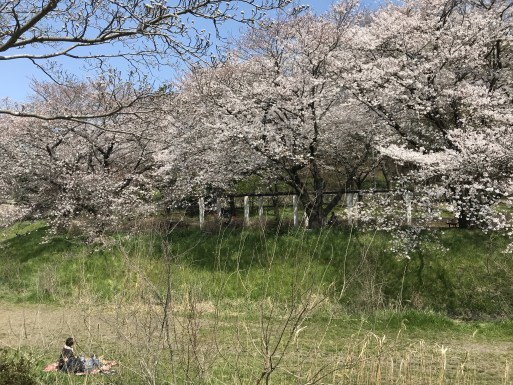Strange Hanami
With the coronavirus throwing an invisible wrench into Tokyo’s routines, this year’s hanami season might be the most curtailed, and the strangest, ever. The mayor of Tokyo asked everyone to restrain themselves from parties under the blossoms, but restraint and hanami is a new combination.
Once upon a time, in the golden age of hanami, giant companies, alumni associations, and groups and circles of all kinds staked out huge tarps in prime spots for when the workday ended (early) and people packed in tight circles, drinking, singing, and letting loose. But this year, things have changed.
Of course, everybody still wants something from the cherry blossoms—bonding, nostalgia, poetic reverie, or Instagram moment, but they seem to have toned down their demands. Or been forced to. The hanami this year are set to shrink to smaller social units—families, couples, a few mothers with kids. There are more people walking than sitting, more daydreaming than drunk-shouting.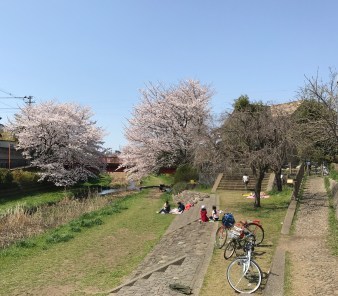
Cherry trees, it seems to me, are the hardest working trees around. Timeworn, dignified and quietly luminescent, they preside over whatever happens below, be it loud or quiet, rowdy or tranquil. Unlike most trees, which shoot up and away from the earth, cherry trees lean down like a grandmother calming a crying child. This year, though, there won’t be many children to embrace.
Every year, I go to at least one park famous for cherry blossoms. It’s crowded but stunning. But now that the coronavirus is dividing our lives into essential and non-essential, I’ll stay close to home. I’m lucky that my nearby park has rows of cherry trees, but that’s the same for most people. I can even see a few cherry trees from my back porch, not unusual in Tokyo, but an honor just the same.
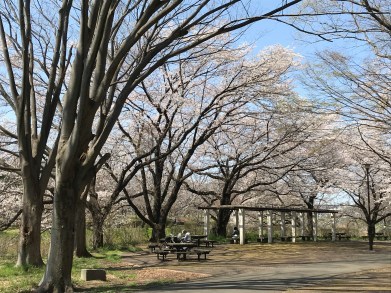 About half the blossoms were out during my usual jog through the park the other day. Near where I turn back home, there’s an old man I often stop and talk to. His house is right next to the walkway that meanders through the park. He is small, wiry and sunbaked. He told me one day he had been featured on a TV show about “super grandfathers.” He jogs a couple hours every day, down to a local temple, and keeps a jump rope on a rail outside his place. He smokes.
About half the blossoms were out during my usual jog through the park the other day. Near where I turn back home, there’s an old man I often stop and talk to. His house is right next to the walkway that meanders through the park. He is small, wiry and sunbaked. He told me one day he had been featured on a TV show about “super grandfathers.” He jogs a couple hours every day, down to a local temple, and keeps a jump rope on a rail outside his place. He smokes.
But more amazing than his physical health is his collection of bonsai. That’s why I spoke to him in the first place, to compliment him on how wonderful they were. I eye them in passing where he leaves them on small shelves of plywood balanced on beer cartons. They spill onto the sidewalk and down a slope to the river to catch sun and rain.
When I stopped to chat, he was focused on the roots of a bonsai that, he told me, was a hundred years old. He said it was given to him by a man living two doors down. Where is he now? I asked. He passed away, he said, and his son moved into an apartment close to the station. The former ‘owner’ had it for sixty years, and he had kept it for the forty years since.
And then he went on to recite the ages of all the rest of his bonsai, dozens and dozens of them scattered across the sidewalk and along the rigged-up shelves outside his home. That one’s twenty years, that’s ten years, that’s twenty-six years old. Even the full-size sakura along the river, he told me, had only been planted when they put in concrete banks forty years ago.
He then told me when they blossomed or bore fruit, which ones were related by cuttings from the parent, and from whom he’d received them, or whether he had sprouted them himself. In short, like a storyteller in some ancient village, he recounted the histories and relations and characteristics of them all.
Because it’s the middle of hanami season, I asked if one with a wide, white blossom was a sakura. He told me it was only twenty years old and explained how hard sakura were to work with. You must start on them before the bark hardens or they won’t turn out interesting. He was disappointed in the one he had, because he had let it get too tall too fast.
It has nice blossoms, I pointed out. He frowned. I looked at the shidare sakura whose branches hung like lit-up willow trees over the curve of the river, and two full somei yoshino cherry trees that eclipsed a bridge.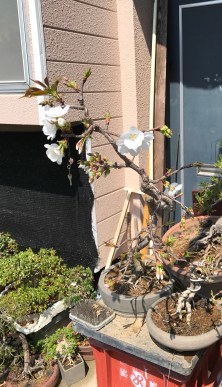
He pointed out another bonsai, down on the back shelf, out of the sunlight. Check out those blossoms, he said. I bent all the way over to look, but I couldn’t see them. He reached down and pushed one up with his rough fingers, and wiggled it back and forth. There were a dozen near-blossoms along the thin branches.
That one will take a long time, he said, waving his round-handled cutting scissors at me. I wondered how long he planned to work on it. He had told me one day he was ninety years old. That’s why he was on TV. Of course, he was working on a one-hundred-year-old tree, the only thing older than him in his collection.
I looked again at the bonsai sakura, elbow-high in its shallow, circular pot, a contrast, or maybe complement, to the riverside trees. I realized he didn’t really think of the bonsai as his own. He was the caretaker for a few decades, before a new caretaker took over.
When I stood back up, it wasn’t his age or vitality, or even his skill with the bonsai that struck me the most. It was more his quick shifts of frame that startled me. He seemed to move so easily between panoramic vista and pinpoint attention, from a hundred years to a tiny blossom.
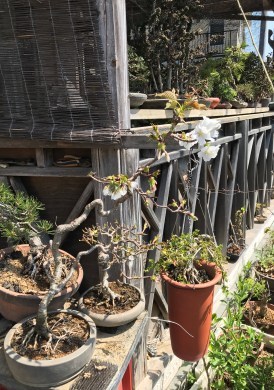 I couldn’t quite think in those terms, nor in the small frame, either. Maybe I’d always been stuck with middling sizes and narrow timeframes. He seemed to encompass the boundaries.
I couldn’t quite think in those terms, nor in the small frame, either. Maybe I’d always been stuck with middling sizes and narrow timeframes. He seemed to encompass the boundaries.
I bowed and apologized to him for interrupting his morning’s work. He smiled and told me to stop by anytime. And I turned back toward home along the river bank.
After I got back into rhythm, I felt that was enough for me—one tiny, curved cherry tree, with just a few blossoms and roots no bigger than my clawed hand. I liked the huge cherry trains arrayed along the river, certainly, and those spreading their branches here and there in the park—even more once I could see them more clearly. But they meant something different than a decades-old bonsai with its power to open my mind and focus it on things that last longer, and are much larger, and much smaller, than my own life.
March 29, 2020